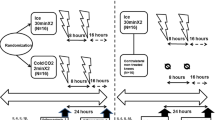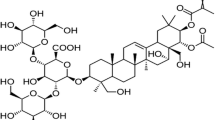Abstract
Objective: Cyclo-oxygenase (COX) exists in two isoforms, COX-1 and COX-2. COX-1 is responsible for homeostatic functions, whereas COX-2 is inducible and responsible for the inflammatory effects of prostaglandins. Nimesulide, a selective inhibitor of COX-2, has been shown to relieve pain rapidly in arthritis. We examined the effect of nimesulide on prostaglandin formation in arthritis, to evaluate if this compound gains access to the site of inflammation and whether this is required for analgesia.
Study Design: This was a single-dose, double-blind, double-dummy, parallel group study of nimesulide 100mg compared with diclofenac 50mg.
Methods: Serial sampling of synovial fluid, whole blood and plasma was performed at baseline and 0.5, 1, 2, 3 and 4 hours after drug administration. Synovial tissue was obtained by needle biopsy at completion of the study period. Synovial fluid prostaglandin E2 (PGE2) was measured by enzyme immunoassay. COX-1 and COX-2 activities in whole blood were estimated by serum thromboxane B2 (TxB2) and endotoxin-induced PGE2 concentrations respectively. Synovial tissue COX-1 and COX-2 mRNA and protein expression were studied by reverse transcriptase polymerase chain reaction and immunohistochemistry respectively.
Twenty atients with acute knee inflammation on a background of arthritis of all types completed the study.
Results: Patients were allocated randomly to groups to receive nimesulide (n = 10) or diclofenac (n = 10). The mean (±SEM) plasma concentration of PGE2 in the nimesulide group decreased from 24.45 ±2.71 ng/mL at baseline to 1.74 ±2.71 ng/ mL at 2 hours. Diclofenac also inhibited PGE2, but at a later time point (28.15 ±2.86 ng/mL at baseline and 0.85 ±2.86 ng/mL at 4 hours). The mean (±SEM) synovial fluid concentration of PGE2 was 319 ±89 pg/mL before treatment; it remained unaltered over 4 hours after the administration of nimesulide or diclofenac (235 ±72 pg/mL). In contrast, in six patients receiving long-term treatment with nimesulide or a non-selective NSAID, synovial PGE2 was 61 ±24 pg/ mL, suggesting that inhibition of synovial prostaglandin formation is delayed compared with that in plasma. Nimesulide caused partial inhibition of serum TxB2 (a decrease from a mean of 268 ±24 ng/mL to one of 164 ±27 ng/mL at 2 hours), whereas diclofenac had a greater effect (a decrease from 224 ±33 ng/mL, to 76 ±27 ng/mL at 3 hours).
Conclusions: Nimesulide, a COX-2 selective inhibitor, has a rapid onset of action in the blood compartment, with early inhibition of PGE2 generation, an index of COX-2 activity. In contrast, it exhibits a delay in achieving therapeutic concentrations in the synovial fluid. Thus factors other than local inhibition of prostaglandins may explain the rapid onset of analgesia that is associated with nimesulide, including a possible central mechanism of pain relief.


Similar content being viewed by others
References
Wolfe F, Zhao S, Lane N. Preference for nonsteroidal antiinflammatory drugs over acetaminophen by rheumatic disease patients: a survey of 1,799 patients with osteoarthritis, rheumatoid arthritis, and fibromyalgia. Arthritis Rheum 2000; 43: 378–85
Meade EA, Smith WL, DeWitt DL. Differential inhibition of prostaglandin endoperoxide synthase (cyclooxygenase) isozymes by aspirin and other non-steroidal anti-inflammatory drugs. J Biol Chem 1993; 268: 6610–14
DeWitt DL, Meade EA, Smith WL. PGH synthase isoenzyme selectivity: the potential for safer nonsteroidal antiinflammatory drugs. Am J Med 1993; 95: 40–4S
Lee SH, Soyoola E, Chanmugam P, et al. Selective expression of mitogen-inducible cyclooxygenase in macrophages stimulated with lipopolysaccharide. J Biol Chem 1992; 267: 25934–8
Dubois RN, Abramson SB, Crofford L, et al. Cyclooxygenase in biology and disease. FASEB J 1998; 12: 1063–73
Warner TD, Giuliano F, Vojnovic I, et al. Nonsteroid drug selectivities for cyclo-oxygenase-1 rather than cyclo-oxygenase-2 are associated with human gastrointestinal toxicity: a full in vitro analysis. Proc Natl Acad Sci U S A 1999; 96: 7563–8
Masferrer JL, Zweifel BS, Manning PT, et al. Selective inhibition of inducible cyclooxygenase 2 in vivo is antiinflammatory and nonulcerogenic. Proc Natl Acad Sci U S A 1994; 91: 3228–32
Bennett A, Villa G. Nimesulide: an NSAID that preferentially inhibits COX-2, and has various unique pharmacological activities. Expert Opin Pharmacother 2000; 1: 277–86
Tavares IA, Bishai PM, Bennett A. Activity of nimesulide on constitutive and inducible cyclooxygenases. Arzneimittelforschung 1995; 45: 1093–5
Cullen L, Kelly L, Connor SO, et al. Selective cyclooxygenase-2 inhibition by nimesulide in man. J Pharmacol Exp Ther 1998; 287: 578–82
Trang LE, Granstrom E, Lovgren O. Levels of prostaglandins F2 alpha and E2 and thromboxane B2 in joint fluid in rheumatoid arthritis. Scand J Rheumatol 1977; 6: 151–4
Seppala E, Nissila M, Isomaki H, et al. Effects of nonsteroidal anti-inflammatory drugs and prednisolone on synovial fluid white cells, prostaglandin E2, leukotriene B4 and cyclic AMP in patients with rheumatoid arthritis. Scand J Rheumatol 1990; 19: 71–5
Chomczynski P, Sacchi N. Single-step method of RNA isolation by acid guanidinium thiocyanate-phenol-chloroform extraction. Anal Biochem 1987; 162: 156–9
Panara MR, Greco A, Santini G, et al. Effects of the novel anti-inflammatory compounds, N-[2-(cyclohexyloxy)-4-nitrophenyl] methanesulphonamide (NS-398) and 5-methanesulphonamido-6-(2,4-difluorothio-phenyl)-1-indanone (L-745,337), on the cyclo-oxygenase activity of human blood prostaglandin endoperoxide synthases. Br J Pharmacol 1995; 116: 2429–34
Bernareggi A. Clinical pharmacokinetics of nimesulide. Clin Pharmacokinet 1998; 35: 247–74
Bianchi M, Broggini M. Anti-hyperalgesic effects of nimesulide: studies in rats and humans. Int J Clin Pharmacol 2002; Suppl. 128: 11–19
Vanegas H, Schaible HG. Prostaglandins and cyclooxygenases in the spinal cord. Prog Neurobiol 2001; 64: 327–63
Author information
Authors and Affiliations
Corresponding author
Rights and permissions
About this article
Cite this article
Duffy, T., Belton, O., Bresnihan, B. et al. Inhibition of PGE2 Production by Nimesulide Compared with Diclofenac in the Acutely Inflamed Joint of Patients with Arthritis. Drugs 63 (Suppl 1), 31–36 (2003). https://doi.org/10.2165/00003495-200363001-00005
Published:
Issue Date:
DOI: https://doi.org/10.2165/00003495-200363001-00005




